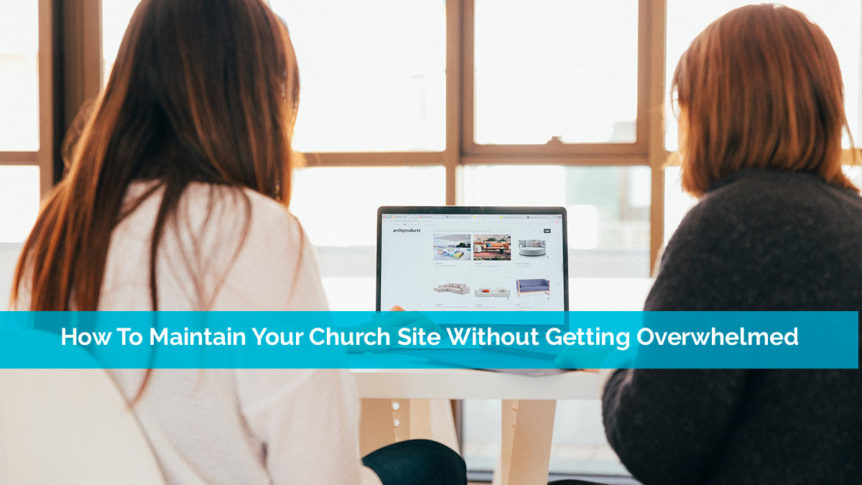It’s easy to say your church doesn’t need a website simply because you don’t have time to maintain it. However, you can maintain your church site without getting overwhelmed.
An up to date website is so important when much of our community is experiencing church digitally for the first time.
Even more important, you’ll be maintaining a place for your members and online followers to join together to worship 24/7.

List Everything You Need To Do Regularly
The first step is to list everything you’ll need to do on a regular basis. Create two lists – weekly and monthly. It’s much easier to handle everything if you know what your tasks are upfront.
Some things you might want to add to your weekly list include:
- Blogging
- Change/update events
- Upload sermon (if you host your sermons)
- Run a backup
- Check analytics data
- Look over comments to weed out any spam not caught by your spam filter
While that might seem like a lot, the only time-consuming task is blogging. However, we’ll help you figure out how to do this a little faster too later on.
Now, it’s time to create your monthly list:
- Check for updates
- Check backups
- Review monthly analytics data
- Update a few older blogs (helps them rank better, but you won’t have to do this for at least 3-6 months)
See, there’s actually not that much to do. It just seems overwhelming at first because most people try to cram in everything at once. If you spread it out, it’s much easier to maintain your church site.
Yes, there are a few yearly tasks you’ll want to consider as well, but these are tasks you’ll likely want to devote a few days to once a year. Pick a time when you’re not quite as busy, such as avoiding major holidays. Your main yearly tasks include:
- Running security checks – You may want to hire a third party to check for security flaws.
- Refreshing your site’s look
- Checking for broken links – Also do this immediately after any major site change, such as moving to a new theme or changing your domain name.
- Reviewing your content strategy – Use analytics data to help with this one.
- Asking members what they’d like to see change, such as new features or removing others
As the proud owners of a church website, there is some extra work involved. However, growing your church and keeping your members more engaged is well worth it.
Set A Schedule
This is the most important step. If you don’t set and stick to a schedule, your church website maintenance tasks will pile up. Then, things will get pushed to the side and your site will suffer.
Instead, sit down and really look at your current obligations. Where could you fit in 30 minutes to an hour each week for your weekly tasks? Where could you fit in an hour or two for a blog post? Which day would you like to set aside for monthly tasks?
Make these regularly occurring in your calendar. Then, you’ll stay on top of your tasks and not feel overwhelmed.

Assign Tasks To Others
You’re probably still thinking that you’re already too busy to handle anything else. It’s true, church leadership is a tough gig. The last thing you need is more to deal with.
However, the best way for pastors and other church leaders to get more out of their limited time is to delegate. Assign some of your tasks to other people. It’s easier to maintain your church site if you’re not doing it all alone.
Ask for volunteers to help wherever possible. You can even get help writing your blog posts. Create an outline or a rough draft and have someone else complete it. You can always review it before it goes live. Volunteers can upload sermons, update events, moderate comments and even ensure backups are properly scheduled.
A little training is all it takes to prep your volunteers to help you better maintain your site in less time.
Create And Check Backups
A major part of maintaining your church website is creating and checking backups. Sadly, many site owners, including major businesses, don’t think they need backups. Even worse, if they do have them, they never check them.
Sometimes, backups are corrupted or the tools you’re using aren’t working correctly. You don’t want to find out the hard way that this is the case. Something as simple as a lost connection during the backup is enough to corrupt it.
First of all, ensure your church site is backed up at least once a week. If you update it more often than that, back it up more often too.
Next, verify your backups work. According to Sucuri, testing is a simple four-step process:
- Create a test domain (you can use the same test domain each time)
- Create an empty web directory for your backup files
- Restore your church website from a backup to the test domain (this avoids interfering with your main site)
- Verify the test site works and all your data is there (spot check blog posts and click each main page)
Doing a check once a month will save you hours of headaches later. You’ve put in too much hard work for your site to be ruined just because you didn’t have a verified backup ready to go.
Check For Updates
Just like your computer, mobile devices and apps, your website needs updates too. These updates include new features, bug fixes and security patches. The most important is obviously the security patches, but the other two are good too.
Your web host may take care of some updates for you, especially if they have their own security software. However, you’ll need to check for updates on the following:
- Main website platform, such as WordPress
- Plugins
- Themes
- Third-party tools (if these are cloud-based the developer will handle the updates, but you may need to refresh your account or site for the updates to install)
Before you perform any major updates, namely website platform and themes, run a full backup. Occasionally, updates don’t go quite as planned and it’s good to have a fallback.

Delete What You’re Not Using
While not absolutely necessary, it’s a good idea to delete what you’re not using. This is a good way to maintain your church site without much effort.
As you try different plugins and themes, the files build up. These can actually slow down your site. Plus, outdated files leave your site vulnerable to hackers.
While you’re checking for updates, uninstall and delete anything you’re no longer using.
Check SEO
Uploading content regularly is a great way to maintain your church site. However, the content you upload matters. Optimized content helps search engines and visitors find your site easier.
Take at least 30 minutes each month to review your SEO. Check to see that your blog posts use natural keyword phrases throughout, usually up to 3% of the post. WordPress plugins like Yoast SEO help with this by giving you a green light if the post is optimized.
The same process applies to your website pages. Once you get the hang of SEO, you won’t really need to check as often.
If you need more guidance on SEO, check out the following guides:
- Everything Your Church Should Know About SEO
- 8 Church SEO Best Practices To Get Your Church Found In Search
- SEO Starter Guide
- Steps To A Google-Friendly Site
Focus On Blog Quality Over Quantity
You could write 10 blog posts every week to bring in more traffic. However, if your posts are high-quality, you could actually be hurting your site. Part of maintaining your site involves keeping the quality of the site high.
It’s a much better strategy to focus on the quality of your blog posts over quantity. A single great post every week or even every two weeks helps your site more than multiple mediocre posts. Plus, you won’t be so overwhelmed trying to write numerous posts every week.
Create A Blog Posting Template
The idea of blogging as a way to maintain your church site may make you groan. However, it really is necessary to make your site an effective marketing tool and online community builder.
Wouldn’t it be nice if you could simplify the process? All you have to do is create a template or set of templates.
For instance, if you want to write a blog post that expands on your weekly sermon, create a template that helps you quickly fill in the blanks, such as:
- Introduction Of Topic
- Recap Of Sermon
- Highlight 3-4 Biggest Points
- Explain Each Point In-Depth
- Wrap Up With Lesson Or Conclusion
- Add Suggested Reading At The End
Odds are, you’ll probably write the same several types of blog posts over and over. You might write more spiritual posts, like a deeper dive into your sermons. You might also write lists, devotionals, member/site visitor questions and event reminders.
Create a template for each. Also, add any desired formatting within each template. A little extra work at first makes blogging easier later on.

Focus On Evergreen Content
While some content will be time-sensitive, such as events, try to make other content more evergreen. Having to go back and update old posts is time-consuming. Evergreen content continues to drive traffic to your site for years because it’s still relevant.
Create A Single Events Section
You naturally want more people to attend church events. However, updating your events on your site isn’t always easy. Make sure you have a dedicated events page or section on your site. Now, you only have to update a single area.
Whenever you talk about events, link to that page or section. Just make sure you keep it up to date. If visitors see old events listed and nothing new, they might not think your church is still active.
Check Analytics For Issues
Analytics are a great way to maintain your church site. Quickly discover which pages are performing well (or not), see what your most popular blog posts are, uncover page errors and find broken links.
Many site owners prefer Google Analytics because it’s free and provides valuable insight into a wide variety of website metrics. Review your analytics to see where your site can improve. Any positive changes you make help your site and church.
Reduce Image Sizes
A faster loading site performs better. A quick and easy way to maintain your church site is to reduce your image sizes. The smaller the file size, the faster pages will load.
Take some time to go through your site’s images to see if you can decrease their size. This might take a while if you already have a site filled with images. Recruit some volunteers to help.
If you need to reduce file sizes, Compressor.io and JPEG Optimizer are free tools that compress images for the web.
Perform User Testing
One of the best ways to maintain your church site is to listen to user feedback. Ask a small group of church members to perform user testing on your site each month. Ask them to do a variety of tasks, such as:
- Loading pages on desktop and mobile
- Watching videos
- Clicking random links throughout your site
- Visiting old blog posts
- Testing logins (if applicable)
- Posting comments (if applicable)
The idea is to see if everything is working okay. Also, place a form on your site to report any issues people find.
Update Your Site
Finally, update your site annually. Add a few new features. Try out a new template. Refresh your homepage header image.
While you don’t have to invest in a costly upgrade, making small tweaks gives your site a fresher look. By doing a little at a time, it’s much easier to maintain. If you wait for 5-10 years before doing anything, you’re looking at a major site overhaul which might seem too drastic for your regular visitors.
A well-designed church website is one that’s easier to maintain without feeling overwhelmed. Check out our web design services for a site you’ll actually enjoy maintaining.




